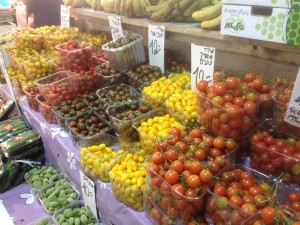The calendar below just marks when the seasons begin, not how long the fruits/vegetables remain in season. Some produce stays in season for a long time, some very short. The calendar below is approximate, and some things have shifted a drop over the years. It is not comprehensive, but comes close.
After the monthly calendar, I also list the produce alphabetically, so you can search to find out when something specific comes into season.
Available Year-Round

Some produce in Israel is available (more or less) the whole year, either due to different varietals, greenhouse cultivation or storage. And there is a small portion of imported produce, also lengthening seasons.
Even though these fruits and vegetables are always available, there are still better times to buy them. For example, apples are better in fall and early winter, citrus fruits and root vegetables in winter, tomatoes in late spring/early summer, etc.
Apples, Bell Peppers, Broccoli, Cabbage, Cauliflower, Celery, Chili Peppers, Citrus Fruits, Cucumbers, Eggplants, Fennel, Garlic (dried), Grapes, Lettuce, Melons (they sell many varieties, all simply sold as “melon,” that ripen throughout the year), Mushrooms, Onions, Potatoes, Radishes, Scallions, Summer Squash (normal dark-green zucchini isn’t always available, but other varieties are), Tomatoes.
January
Mangold, Pomelo
(Citrus fruits — oranges, lemons, clementines, grapefruits — are starting to hit their prime.)
February
Asparagus, Bok Choy, Cardoon, Hass Avocado (other avocados are available before and after), Kumquat
Late February
Chamomile, Fava Beans, Loquat, Passionfruit, Pea, Rhubarb
March
Fresh Almond, Blood Orange, Fresh Chickpea, Grape Leaves
Late March
Baby Eggplant, Corn (available, but not very good until June), Fresh Garlic (not dried, available starting a few weeks before Passover)
April
Papaya
Late April
Cherry, Green Sour Plums, Nectarine, Peach, Watermelon, Winter Squashes (e.g. acorn, butternut, kobocha/Japanese pumpkin)
May
Akub (Hebrew/Arabic name, aka Gundelia or Thorn Thistle – a type of small wild artichoke), Apricot, Okra, Pineapple (tiny now, bigger in a few months), Plum, Wax Bean
June
Fig, Lychee
July
Blackberry, Mango, Raspberry
Late July
Pomegranate
August
Avocado, Dragonfruit, Fresh Date, Jujube, Quince, Sabra (Prickly Pear/Cactus Fruit)
September
Banana, Lime, Pear
October
Carambola/Star Fruit, Custard Apple/Annona, Guava, Kiwi, Persimmon, Raw Olives (for home pickling)
(Root vegetables starting to get large.)
November
Baby Artichoke, Strawberry
December
Artichoke
Alphabetical list of Produce in Season
| Acorn Squash – Late April Akub – May Almonds (fresh) – March Annona – see Custard Apple Apples – Year-round Apricots – May Artichokes – December Artichokes, Baby – November Asparagus – February Avocado – August Avocado, Hass – February Bananas – September Bell Peppers – Year-round Blackberries – July Blood Oranges – March Bok Choy – February Broccoli – Year-round Butternut Squash – Late April Cabbage – Year-round Cactus Fruit – see Sabra Carambola – see Star Fruit Cardoon – February Cauliflower – Year-round Celery – Year-round Chamomile (fresh) – Late February Cherries – Late April Chickpeas (fresh) – March Chili Peppers – Year-round Corn – Late March Cucumbers – Year-round Custard Apple – October Dates (fresh) – August Dragonfruit – August Eggplants – Year-round Eggplants, Baby – Late March Fava Beans – Late February Fennel – Year-round Figs – June Garlic (dried) – Year-round Garlic (fresh) – Late March Grapes – Year-round Grape Leaves – March Grapefruits – Year-round Guava – October Gundelia – see Akub Japanese Pumpkin – see Kobocha |
Jujube – August Kiwi – October Kobocha – Late April Kumquats – February Lemons – Year-round Lettuce – Year-round Limes – September Loquats – Late February Lychee – June Mango – July Mangold – January Melons – Year-round Mushrooms – Year-round Nectarines – Late April Okra – May Olives (raw) – October Onions – Year-round Oranges – Year-round Oranges, Blood – March Papaya – April Passionfruit – Late February Peaches – Late April Peas – Late February Pears – September Persimmon – October Pineapple – May Plums – May Plums, Green Sour – Late April Pomegranate – Late July Pomelos – January Potatoes – Year-round Prickly Pear – see Sabra Quince – August Radishes – Year-round Raspberries – July Rhubarb – Late February Sabra – August Scallions – Year-round Star Fruit – October Strawberries – November Summer Squash – Year-round Thorn Thistle – see Akub Tomatoes – Year-round Watermelon – Late April Wax Beans – May Winter Squash – Late April |
